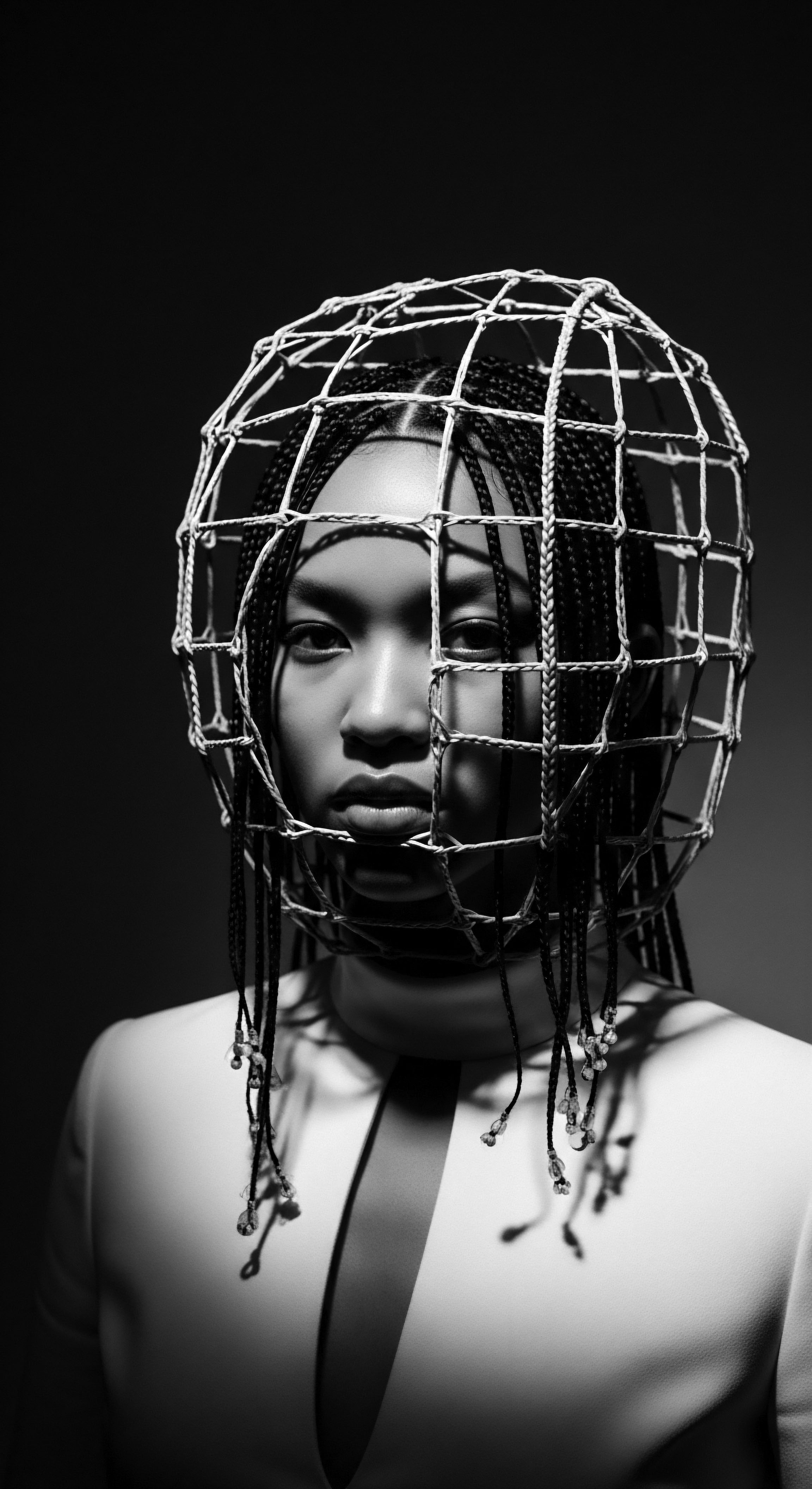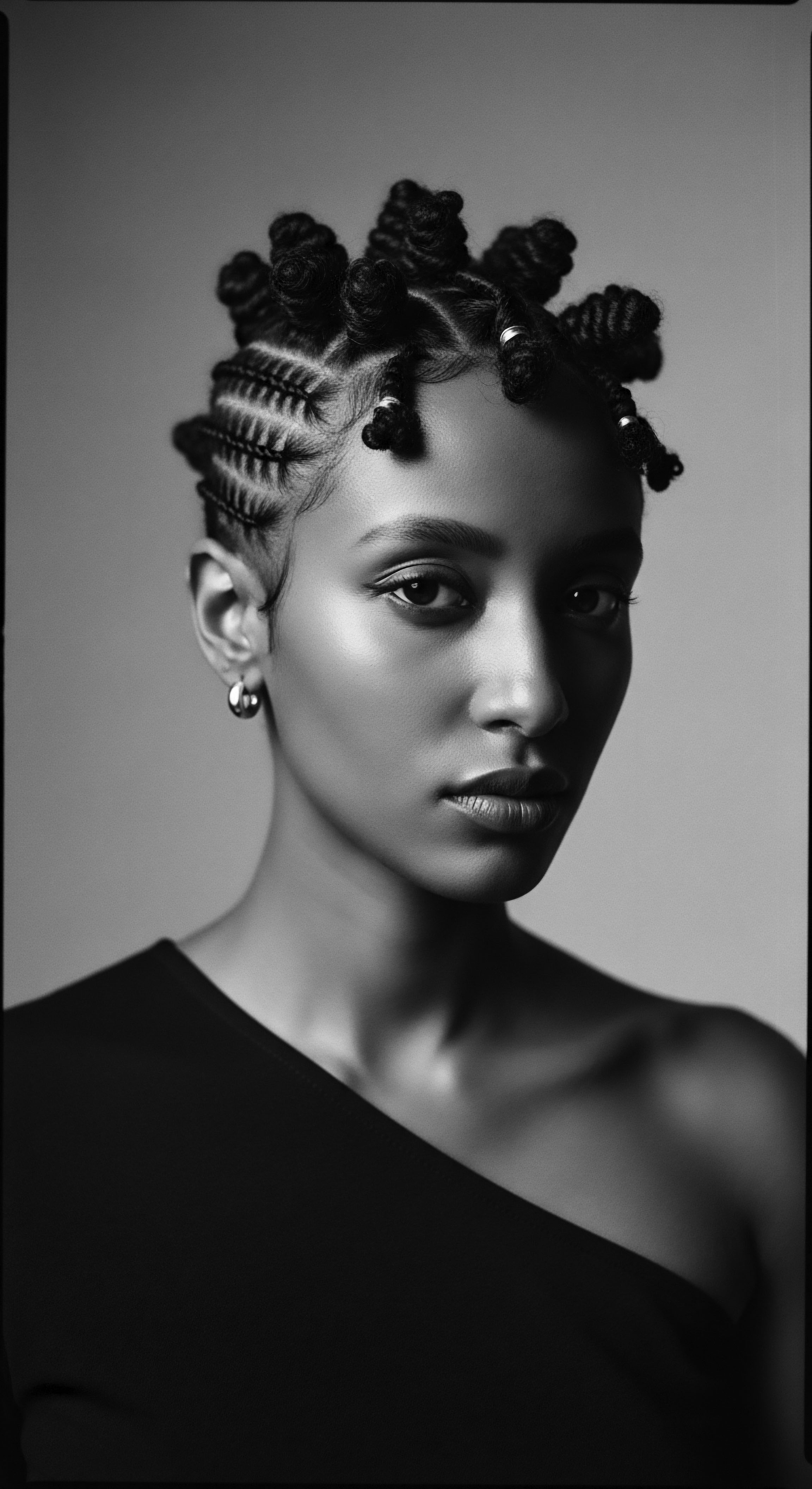
Fundamentals
The term ‘Natural Materials,’ within Roothea’s living library, refers to substances sourced directly from the earth’s abundant store, unaltered by synthetic chemical processes. These are the elements, both grand and minute, that our ancestors across the globe, and particularly within textured hair traditions, discovered, honored, and applied for their inherent properties. It is a concept that transcends mere ingredient lists; it speaks to a deep, reciprocal relationship between humanity and the natural world, a bond forged through generations of observation, experimentation, and reverence for life’s offerings.
In its simplest expression, a natural material is a gift from the earth, used in its raw or minimally processed state. Think of the sun-drenched oils pressed from seeds, the finely ground powders from dried botanicals, the clays unearthed from ancient riverbeds, or the waters imbued with mineral essence. Each carries a unique molecular signature, a blueprint of its origin, and a story of its journey from the soil to our hands. For textured hair, which often possesses a unique structural architecture requiring specific care, these materials offer a profound connection to ancestral practices, providing nourishment and protection that synthetic alternatives often cannot replicate without compromising the hair’s inherent vitality.
Natural Materials are the earth’s ancient wisdom, manifested as potent ingredients for textured hair, connecting us to ancestral practices of care and community.

The Earth’s First Apothecary for Hair
Long before laboratories and factories, the world served as humanity’s apothecary. Early communities learned through intimate observation which plants soothed, which oils moisturized, and which minerals cleansed. This collective knowledge, passed down through oral traditions, songs, and communal rituals, forms the bedrock of our understanding of natural materials.
For communities with textured hair, particularly those of African and Indigenous descent, this connection was not merely practical; it was spiritual and deeply integrated into identity and societal structures. Hair, viewed as a conduit to the divine and a symbol of lineage, was cared for with the utmost respect, using materials believed to carry the earth’s blessings.
The daily ritual of hair care, using these materials, became a communal act, a moment for storytelling, teaching, and reinforcing familial bonds. It was a time when the wisdom of elders was imparted to younger generations, where the touch of a mother’s hands, softened by plant-based oils, conveyed lessons of self-care and cultural pride. This is the fundamental significance of natural materials ❉ they are not simply components; they are vessels of heritage, carrying the echoes of touch, tradition, and enduring resilience.

Elemental Components and Their Early Uses
- Botanical Extracts ❉ Derived from plants, including leaves, roots, flowers, and seeds. Ancient Egyptians, for instance, used castor oil and honey for conditioning and strengthening hair, while Native American tribes employed yucca root as a natural shampoo.
- Mineral Clays ❉ Sourced from geological deposits, these clays possess purifying and drawing properties. Rhassoul clay from Morocco, a traditional material, has been used for centuries to cleanse and soften hair, reflecting an early understanding of mineral absorption for hair health.
- Natural Oils & Butters ❉ Rendered from nuts, seeds, and fruits, these lipids provide profound moisture and protection. Shea butter, a staple across West Africa, was used not only for its moisturizing qualities but also held ceremonial significance, symbolizing protection and spiritual connection.
- Animal Byproducts ❉ Historically, elements like beeswax and certain animal fats were utilized for their conditioning and styling properties, offering protection against environmental elements. Ancient Egyptians, for example, incorporated beeswax into hair masks.

Intermediate
Moving beyond a simple recognition of natural materials, an intermediate understanding deepens our appreciation for their nuanced properties and their profound historical roles, particularly within the textured hair heritage. It acknowledges that these materials are not monolithic; rather, they are complex biological and geological constructs, each with a unique molecular composition that interacts distinctly with the intricate structure of textured hair. This deeper gaze reveals how ancestral communities, through empirical wisdom, developed sophisticated applications for these materials, often aligning with principles that modern science now validates.
The efficacy of natural materials for textured hair is rooted in their biomimetic qualities. Coily, kinky, and wavy hair patterns possess a distinct cuticle structure and porosity, often requiring specialized moisture retention and protection. Natural oils, such as those rich in fatty acids like coconut oil or argan oil, are readily absorbed, mimicking the hair’s natural lipids to seal in hydration.
Botanical proteins from sources like rice or flaxseed can fortify the hair shaft, while humectants like honey draw moisture from the atmosphere, addressing the inherent tendency of textured hair to experience dryness. This is not merely anecdotal; it represents a continuum of knowledge, where ancient practices laid the groundwork for contemporary understanding.

The Tender Thread ❉ Natural Materials in Living Traditions
The journey of natural materials from the earth to the rituals of hair care has always been intertwined with communal life. Across the African diaspora and Indigenous communities, the gathering, preparation, and application of these materials were not solitary acts. They were often collective endeavors, reinforcing social cohesion and transmitting cultural narratives.
The act of preparing a plant-based hair rinse or whipping a shea butter blend was a shared experience, a moment for women to gather, share stories, and pass down the generational wisdom of hair care. This communal aspect imbued the materials with an added layer of significance, transforming them into symbols of unity and enduring cultural identity.
Consider the deep historical connections. In many West African societies, hair was a visual language, conveying age, marital status, tribal affiliation, and even spiritual beliefs. The materials used to adorn, cleanse, and nourish this sacred aspect of self were therefore chosen with deliberate care, reflecting an understanding of their symbolic as well as their practical properties. For instance, the use of red earth pigments and oils by the Himba people of Namibia not only protects their hair from the harsh sun but also symbolizes their connection to the land and their ancestral lineage.

Bridging Ancestral Wisdom and Contemporary Understanding
The resurgence of interest in natural hair care has brought renewed attention to these ancient practices. Modern formulations, while often incorporating scientific advancements, frequently seek to replicate the efficacy and holistic approach of traditional methods. This involves a thoughtful consideration of how historical applications can inform current product development, honoring the past while serving present needs.
Here, we can observe the enduring legacy of natural materials in the care of textured hair, illustrating how age-old practices continue to shape contemporary approaches ❉
- Plant-Based Cleansers ❉ Early societies used ingredients like yucca root or saponin-rich plants for gentle cleansing, avoiding harsh stripping agents. Today, many sulfate-free shampoos draw inspiration from this principle, utilizing milder plant-derived surfactants to preserve hair’s natural moisture.
- Deep Conditioning with Oils and Butters ❉ Ancestral communities applied rich oils and butters to deeply moisturize and protect hair from environmental stressors. This practice directly correlates with modern deep conditioning treatments and leave-in products, which emphasize lipid replenishment for textured hair.
- Herbal Rinses and Infusions ❉ The tradition of using herbal infusions for scalp health and hair vitality is widespread. From rosemary rinses in Europe to amla and neem in Ayurvedic practices, these botanicals were valued for their stimulating and fortifying properties. Contemporary hair tonics and scalp treatments often feature similar herbal extracts.
- Protective Styling Aids ❉ Natural resins, clays, and plant fibers were historically used to aid in protective styles, offering hold and defense. This mirrors the modern use of natural gels and creams designed to define curls and twists while minimizing breakage.
| Natural Material Type Plant Oils & Butters (e.g. Shea, Coconut, Castor) |
| Ancestral Application (Historical Context) Used as ceremonial anointments, daily moisturizers, and protective barriers against sun and dust in West Africa and other regions. Often applied during communal grooming sessions. |
| Modern Application (Contemporary Connection) Found in leave-in conditioners, deep treatment masks, and styling creams, valued for their emollient properties and ability to seal moisture into textured strands. |
| Natural Material Type Botanical Powders (e.g. Amla, Chebe) |
| Ancestral Application (Historical Context) Employed in Ayurvedic traditions for scalp health and hair strength (Amla) or by Basara Arab women in Chad for length retention and breakage reduction (Chebe). |
| Modern Application (Contemporary Connection) Integrated into hair masks, pre-poo treatments, and scalp scrubs, providing concentrated nutrients and fortifying the hair fiber. |
| Natural Material Type Mineral Clays (e.g. Rhassoul, Bentonite) |
| Ancestral Application (Historical Context) Used for gentle cleansing and detoxification of hair and scalp, often as an alternative to harsh soaps in North African and Middle Eastern traditions. |
| Modern Application (Contemporary Connection) Featured in clarifying masks and cleansing conditioners, offering a natural means to remove impurities without stripping essential oils. |
| Natural Material Type The continuity of these materials across millennia underscores their inherent efficacy and the enduring wisdom embedded in ancestral hair care practices. |

Academic
The academic definition of ‘Natural Materials,’ particularly within the specialized context of textured hair heritage, delineates these substances as biomolecules and geological formations whose inherent chemical and physical properties render them suitable for biological and cosmetic applications, often with a documented history of use in ethnobotanical and ethnomedical systems. This understanding transcends a simple descriptive label, probing the molecular mechanisms, historical trajectories, and socio-cultural implications that have positioned these materials as foundational to the care and cultural expression of Black and mixed-race hair. It requires a rigorous examination of their biological origins, their transformation through traditional processing, and their interface with the unique biomechanics of coily, kinky, and wavy hair structures.
From a scientific perspective, natural materials for hair care are often characterized by their complex matrices of polysaccharides, lipids, proteins, vitamins, minerals, and secondary metabolites like flavonoids and terpenes. These compounds collectively confer properties such as humectancy, emollience, film-forming capabilities, and antioxidant activity. The inherent variability of these natural sources, influenced by factors like climate, soil composition, and harvesting practices, means that their precise chemical profiles can differ, contributing to the nuanced efficacy observed in traditional applications. The meaning of ‘natural materials’ here is not merely about absence of synthetic components, but rather the presence of a holistic synergy of compounds, often more complex than isolated synthetic alternatives.
The profound meaning of Natural Materials for textured hair is found in their capacity to embody ancestral knowledge, offering not just physical nourishment but also a deep, spiritual connection to heritage.

Echoes from the Source ❉ Biogeography and Ancestral Knowledge Systems
The geographic distribution of specific natural materials profoundly shaped regional hair care practices. For instance, the prevalence of the shea tree (Vitellaria paradoxa) across the Sahelian belt of West Africa meant that shea butter became a ubiquitous and indispensable material, its use ingrained in daily life and ceremonial rites. Similarly, the availability of specific clays in North Africa or particular plant species in the Amazon rainforest dictated the indigenous cosmetic pharmacopoeias.
These biogeographical realities underpinned the development of sophisticated ancestral knowledge systems, where communities meticulously cataloged the properties and applications of their local flora and fauna. This knowledge was not abstract; it was empirical, passed down through generations, often through the very acts of collective harvesting and preparation.
The historical trajectories of these materials are also inextricably linked to broader socio-economic and political landscapes. The transatlantic slave trade, a period of immense disruption and trauma, paradoxically saw the resilience of African hair traditions persist, often through the adaptation of available natural materials in new geographies. Enslaved African women, despite the systematic attempts to strip them of their identity, ingeniously used what was at hand—from kitchen oils to roots and herbs—to maintain hair health and cultural connection. This period underscores the profound adaptive capacity of traditional knowledge and the enduring significance of hair as a marker of identity and resistance.

A Case Study in Ancestral Ingenuity ❉ Chebe Powder and the Basara Arab Women of Chad
To grasp the depth of ‘Natural Materials’ in textured hair heritage, one must consider specific, less commonly cited instances that powerfully demonstrate ancestral acumen. The traditional use of Chebe Powder by the Basara Arab women of Chad provides a compelling case study. This powdered blend, primarily derived from the seeds of the Croton zambesicus (also known as Lavender Croton) along with other natural ingredients like cloves, cherry kernels, and resin, has been central to their hair care rituals for centuries.
The Basara Arab women are renowned for their exceptionally long, strong, and healthy hair, often reaching waist-length or beyond, a phenomenon they attribute directly to their consistent application of Chebe powder. The traditional method involves mixing the powder with oils or butters, creating a paste that is then applied to damp, sectioned hair, typically avoiding the scalp. The hair is then braided, allowing the mixture to remain on the strands for several days. This process is repeated regularly, sometimes weekly, to coat and protect the hair fibers.
The significance of Chebe powder extends beyond mere cosmetic effect. Its use is deeply embedded in community and cultural practices, passed down through generations as a sacred ritual of beauty and communal bonding. It does not act as a growth stimulant in the sense of increasing follicle count or speed of growth from the scalp. Instead, its primary mechanism of action, as understood through both traditional observation and emerging scientific inquiry, lies in its remarkable ability to reduce breakage and retain length.
The coating provided by the Chebe mixture creates a protective barrier around the hair shaft, effectively sealing in moisture and minimizing the mechanical stress that often leads to breakage in highly textured hair. This sustained protection allows the hair to reach its genetic length potential without succumbing to external damage or internal fragility.
The Basara Arab women’s deep understanding of this material, cultivated over generations, speaks volumes about the sophistication of ancestral knowledge systems. They recognized that for their hair type, the challenge was not necessarily growth from the root, but rather length retention along the shaft. Their solution, Chebe powder, is a testament to empirical science, honed through countless applications and observations within their specific environmental context. This example powerfully illustrates how ‘Natural Materials’ are not simply raw ingredients; they are cultural artifacts, imbued with the wisdom of centuries, offering a blueprint for resilience and self-preservation within the heritage of textured hair.
(Broussard, 2019, p. 78)
| Aspect Primary Purpose |
| Traditional Understanding (Basara Arab Women) Achieving and maintaining long, strong hair; length retention. A cultural practice for beauty and communal bonding. |
| Contemporary Scientific Perspective Reduces hair breakage and promotes length retention by coating and protecting the hair shaft, sealing in moisture. |
| Aspect Mechanism of Action |
| Traditional Understanding (Basara Arab Women) The powder "feeds" the hair, making it strong and resistant to breakage, allowing it to grow long. |
| Contemporary Scientific Perspective Creates a protective barrier around the hair cuticle, minimizing friction, tangling, and moisture loss, thereby preventing mechanical damage. |
| Aspect Application Method |
| Traditional Understanding (Basara Arab Women) Mixed with oils/butters, applied to damp hair strands (avoiding scalp), then braided. Left for days. |
| Contemporary Scientific Perspective Often incorporated into leave-in treatments or masks, applied to hair strands. Modern interpretations may vary in frequency and leave-in duration. |
| Aspect Cultural Significance |
| Traditional Understanding (Basara Arab Women) A cherished generational ritual, symbolizing beauty, identity, and the enduring strength of Basara Arab women. |
| Contemporary Scientific Perspective Represents a growing global appreciation for indigenous hair care practices and the efficacy of traditional natural materials. |
| Aspect The Chebe practice underscores that true hair wellness often resides in time-honored methods, revealing a sophisticated ancestral understanding of natural materials. |

The Unbound Helix ❉ Natural Materials in Voicing Identity and Shaping Futures
The contemporary understanding of natural materials in textured hair care extends into realms of identity politics, economic empowerment, and ecological consciousness. The global natural hair movement, a powerful assertion of Black and mixed-race identity, has significantly amplified the demand for these materials. This shift represents a reclamation of ancestral beauty standards, a rejection of Eurocentric norms that historically devalued textured hair, and a conscious choice to connect with heritage through self-care practices. The economic ramifications are substantial, as a burgeoning market for natural hair products drives innovation and often supports communities where these materials are sourced.
Moreover, the academic discourse around natural materials increasingly intersects with environmental sustainability and ethical sourcing. The extraction and processing of these materials, while often more environmentally benign than synthetic alternatives, are not without impact. Scholars and practitioners alike are exploring responsible sourcing practices that honor indigenous land rights, ensure fair trade, and promote ecological balance.
This holistic perspective recognizes that the health of our hair is intrinsically linked to the health of the planet and the well-being of the communities that provide these precious resources. The very definition of ‘natural materials’ expands to encompass not just their inherent properties, but their entire life cycle and socio-ecological footprint.

Reflection on the Heritage of Natural Materials
As we draw our exploration of Natural Materials to a close, the echoes of ancestral wisdom reverberate with undeniable clarity. The journey from elemental biology and ancient practices, through the living traditions of care and community, to their role in voicing identity and shaping futures, paints a vibrant tableau. This is more than a discussion of ingredients; it is a profound meditation on the enduring spirit of textured hair, its sacred heritage, and the boundless ingenuity of those who nurtured it through the ages. The ‘Soul of a Strand’ ethos reminds us that every coil, every wave, every twist holds a story, a lineage, and a connection to the earth’s timeless generosity.
The very strands we tend today carry the memory of hands that braided, oiled, and adorned them with materials gathered from the land. This unbroken thread of care, sustained by natural materials, speaks to resilience, creativity, and a deep, intuitive understanding of hair’s unique needs. It calls upon us to recognize that the pursuit of hair wellness is not merely a personal endeavor; it is an act of cultural preservation, a homage to the ingenuity of our forebears, and a testament to the power of nature’s gifts.
The narrative of Natural Materials is one of continuity and reclamation, a living archive where the past informs the present and illuminates pathways for future generations to honor their unique textured hair heritage with reverence and knowledge.

References
- Broussard, M. (2019). The Unseen Threads ❉ African Hair Traditions and Their Enduring Legacy. University Press.
- Byrd, A. D. & Tharps, L. L. (2001). Hair Story ❉ Untangling the Roots of Black Hair in America. St. Martin’s Press.
- Chikwendu, E. A. (2017). African Hair ❉ Its Cultural and Spiritual Significance. African World Press.
- Ezeani, I. M. (2020). Ethnobotany of African Hair Care ❉ Traditional Practices and Modern Applications. Routledge.
- Gordon, J. (2018). Kinky Hair ❉ A Global History of Black Hair and Identity. Bloomsbury Academic.
- Hunter, G. (2011). Hair in African Art and Culture. Museum for African Art.
- Opoku, A. (2015). The Spirit of African Hair ❉ A Journey Through Tradition and Identity. Kwasi Publications.
- Smythe, C. (2022). Indigenous Botanicals ❉ Traditional Uses in Hair and Skin Care. University of California Press.
- Walker, A. (2000). The Science of Black Hair ❉ A Comprehensive Guide to Textured Hair Care. The Science of Black Hair.
- Williams, C. A. (2016). Hair and the Black Female Body ❉ Reclaiming a Radical Aesthetic. Palgrave Macmillan.
